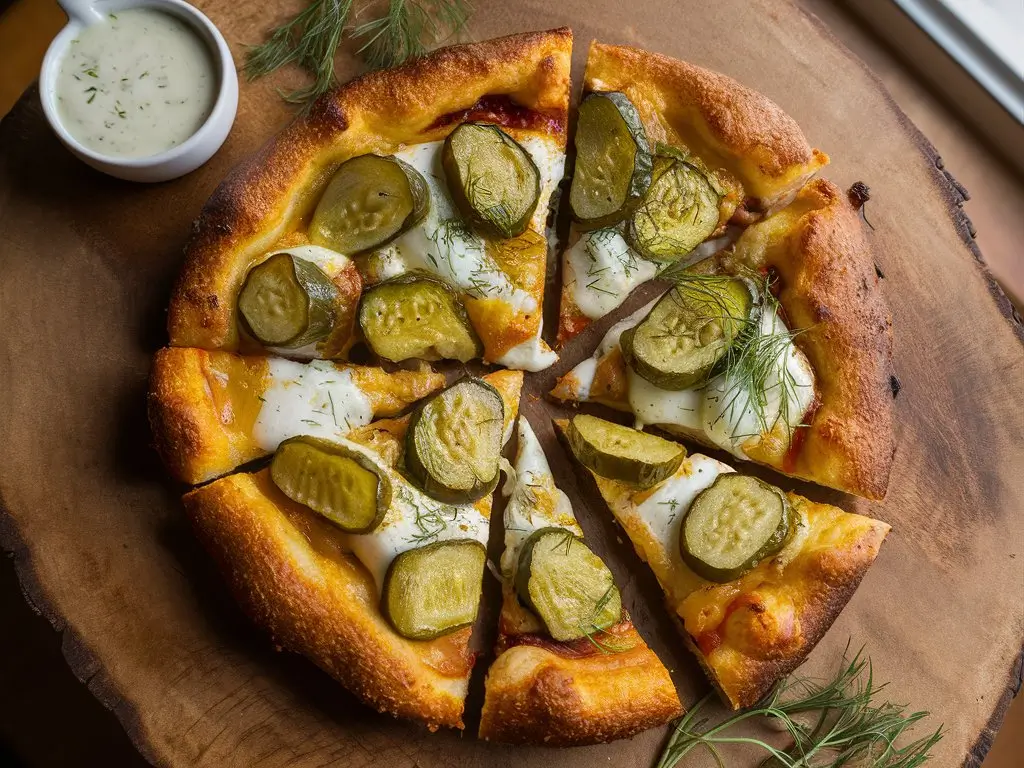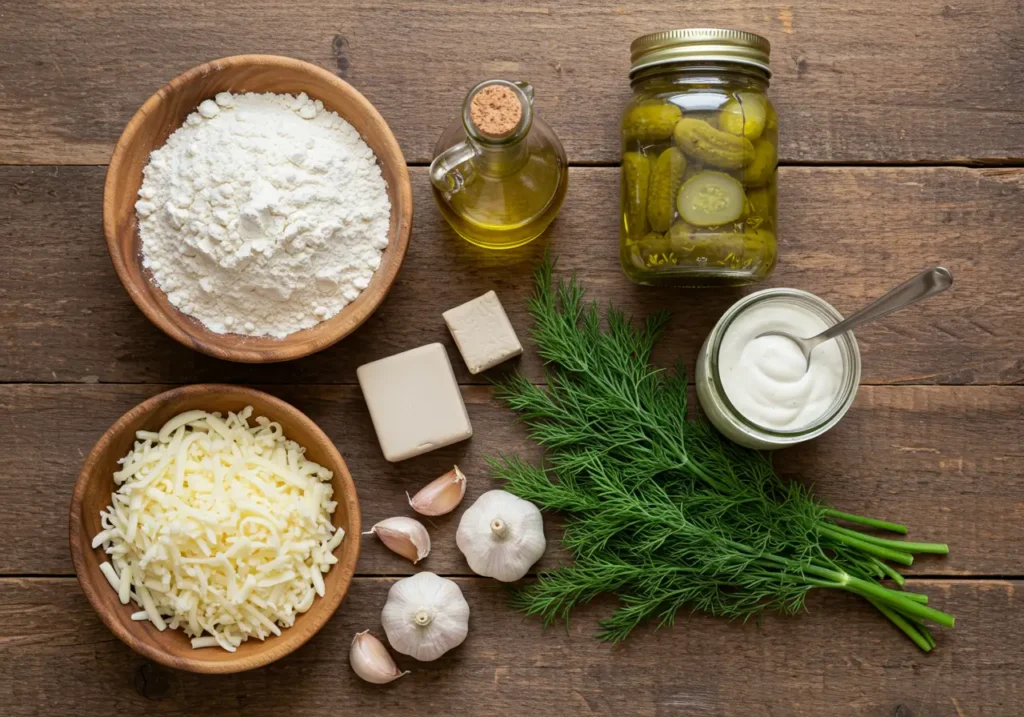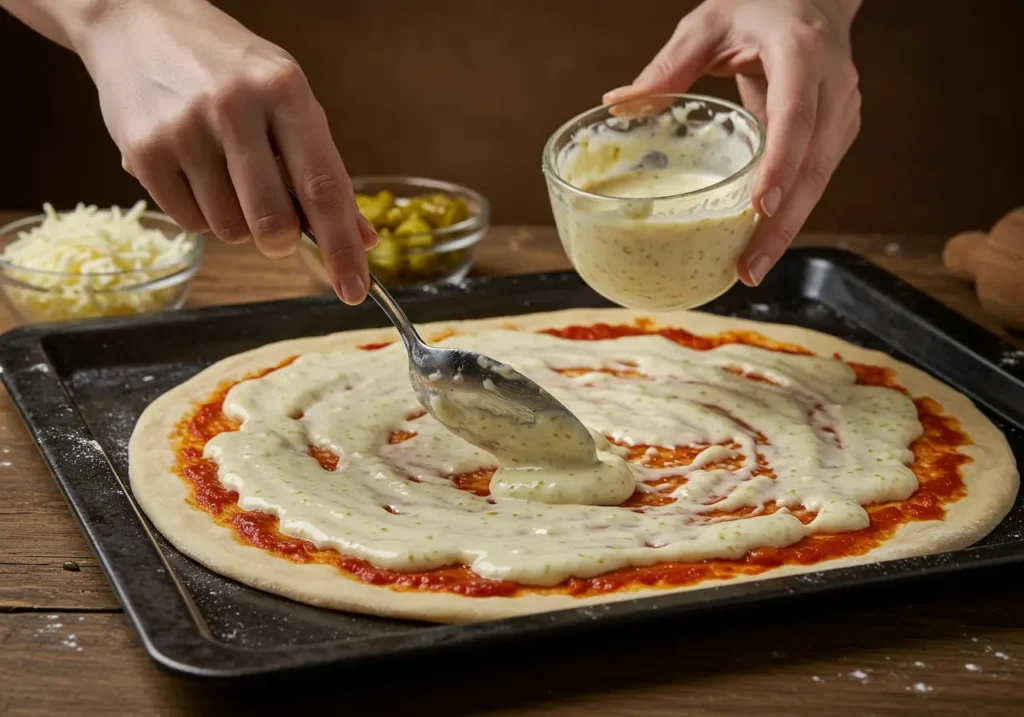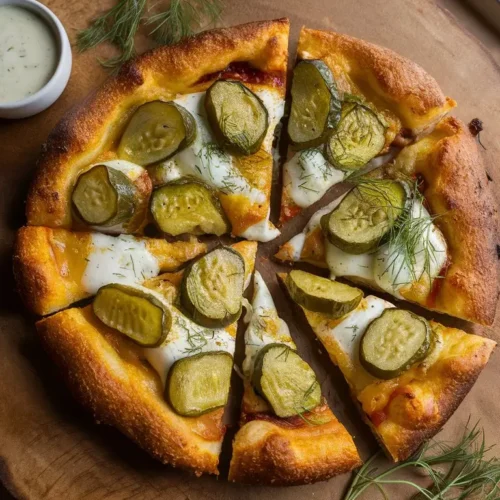If you’ve never tried Pickle Pie Pizza, prepare for a flavor revelation that’ll flip your pizza night upside down—in the best way possible. Picture this: a golden crust slathered with creamy garlic sauce, topped with tangy dill pickles and gooey mozzarella. One bite, and I was hooked—seriously, who knew pickles on pizza could be this good? This isn’t just another pizza recipe; it’s a bold, briny adventure that’s earned its spot as the best dill pickle pizza recipe on The Modern Recipes. Whether you’re a pickle fanatic or just curious about dill on pizza, this dish delivers a punch of flavor that’s equal parts quirky and crave-worthy.

What makes Pickle Pie Pizza so special? It’s the perfect balance of creamy, tangy, and savory, with a pickle ranch pizza twist that keeps you coming back for more. In this guide, I’ll walk you through every step to create your own dill pickle pizza recipe at home, plus share expert tips to nail it on the first try. From the dough to the toppings, we’ve got you covered with a recipe that’s as easy as it is unforgettable. Ready to impress your taste buds (and maybe your friends, too)? Let’s dive into this Pickle Pie Pizza magic!
Table of Contents
Why I Love This Pickle Pie Pizza
I’ll admit it: the first time I heard about Pickle Pie Pizza, I raised an eyebrow. Pickles? On pizza? But once I tasted that briny, tangy goodness paired with a creamy garlic sauce, I was sold—this dill pickle pizza recipe is pure genius. It’s not just a gimmick; it’s a flavor-packed rebellion against boring pizza nights. Hailing from the Midwest, where pickles on pizza became a quirky cult favorite, this dish has since won over foodies everywhere, including me. On The Modern Recipes, it’s one of those recipes that sparks curiosity and delivers big time.
So, why do I love Pickle Pie Pizza? For starters, it’s a texture dream—crisp crust, melty cheese, and crunchy pickles in every bite. The tangy dill cuts through the richness of the mozzarella and ranch, making it a standout pickle ranch pizza that’s both bold and balanced. It’s versatile, too. Want the best dill pickle pizza recipe for a party? Add some spicy jalapeños. Hosting a cozy night in? Keep it classic with extra dill. It’s a conversation starter—trust me, your guests will be asking, “How’d you make this?!”
Beyond the taste, there’s something playful about Pickle Pie Pizza. It’s a reminder that food should be fun, not fussy. Whether you’re a pickle purist or just dipping your toes into dill on pizza, this recipe offers endless ways to tweak it to your liking. I’ve tried it with smoky bacon, swapped the ranch for a garlicky white sauce (inspired by our Garlic Butter Sauce), and even gone gluten-free—every version shines. It’s low-effort, high-reward cooking that proves you don’t need fancy ingredients to make something extraordinary. Curious to whip up your own? Keep reading for the full rundown!
Ingredients
Creating the perfect Pickle Pie Pizza starts with quality ingredients that bring this quirky dish to life. Whether you’re chasing the best dill pickle pizza recipe or tweaking it into a pickle ranch pizza, every component plays a role in that tangy, creamy magic. Here’s what you’ll need, why it matters, and some handy swaps to make it your own.
For the Dough
- 1 ½ cups all-purpose flour: The foundation of your crust—gives it structure and a satisfying chew.
- 1 tsp active dry yeast: Makes the dough rise for that airy, crispy edge.
- 1 tsp sugar: Feeds the yeast and adds a subtle sweetness to balance the pickles.
- ½ tsp salt: Enhances flavor—don’t skip it!
- ¾ cup warm water: Activates the yeast; aim for 100-110°F.
- 1 tbsp olive oil: Keeps the dough soft and adds a hint of richness.
- Substitution: Swap for a gluten-free flour blend if you’re avoiding wheat—just check the yeast compatibility.
For the Garlic Sauce
- ½ cup ranch dressing: The creamy base of our dill pickle pizza garlic sauce recipe. Use store-bought or whip up your own from The Modern Recipes.
- 2 cloves garlic, minced: Fresh is best for that punchy, aromatic kick.
- 1 tsp dried dill: Boosts the pickle vibe—double it if you’re dill-obsessed like me.
- 1 tbsp olive oil: Smooths out the sauce and ties it all together.
- Substitution: Try Greek yogurt instead of ranch for a lighter pickle ranch pizza twist.
Toppings
- 1 cup shredded mozzarella cheese: Melts into gooey perfection, balancing the tangy pickles on pizza.
- ½ cup dill pickles, thinly sliced: The star of Pickle Pie Pizza—go for crisp, high-quality dills.
- ¼ cup pickle juice (optional): Drizzle it on for extra zing; it’s a game-changer in this dill pickle pizza recipe.
- 1 tsp fresh dill, chopped: A final flourish for flavor and looks—dried works in a pinch.
- Substitution: Swap mozzarella for cheddar or a vegan cheese to mix it up.
Each ingredient in Pickle Pie Pizza pulls its weight. The dough gives you a sturdy canvas, the garlic sauce brings creamy depth, and the pickles on pizza deliver that signature tang. Want to experiment? Add bacon for smokiness or sprinkle red pepper flakes for heat. Whatever you choose, you’re building a pizza that’s as bold as it is delicious. Ready to assemble? Let’s roll!

Step-by-Step Instructions
Making Pickle Pie Pizza is easier than you’d think, and the payoff is a tangy, cheesy masterpiece that’ll have everyone asking for seconds. This dill pickle pizza recipe walks you through every step, with expert tips to ensure your crust is crisp, your sauce is dreamy, and your pickles on pizza shine. Let’s get cooking!
Step 1: Prepare the Dough
- In a large bowl, combine 1 tsp active dry yeast, 1 tsp sugar, and ¾ cup warm water (100-110°F). Let it sit for 5-10 minutes until foamy—proof it’s alive!
- Add 1 ½ cups all-purpose flour, ½ tsp salt, and 1 tbsp olive oil. Stir until a shaggy dough forms, then knead on a floured surface for 5-7 minutes until smooth.
- Place the dough in an oiled bowl, cover with a damp cloth, and let it rise for 1 hour in a warm spot—it should double in size.
- Expert Tip: If the dough feels sticky, add a sprinkle of flour, but don’t overdo it—too much kills the chewiness.
- Troubleshooting: No rise? Your water might’ve been too hot (it kills yeast) or too cold (it slows it down). Start over with the right temp.
Step 2: Make the Garlic Sauce
- In a small bowl, mix ½ cup ranch dressing, 2 minced garlic cloves, 1 tsp dried dill, and 1 tbsp olive oil. Stir until smooth—this is your dill pickle pizza garlic sauce recipe.
- Taste and adjust—extra dill or a pinch of salt can elevate it.
- Expert Tip: For a bolder pickle ranch pizza vibe, add a splash of pickle juice to the mix.
- Troubleshooting: Too thick? Thin it with a teaspoon of water or oil.
Step 3: Roll Out the Dough
- Preheat your oven to 425°F (220°C). Punch down the risen dough and roll it out on a floured surface to a 12-inch circle—or thinner if you love a crispy crust.
- Transfer to a baking sheet or pizza stone dusted with cornmeal to prevent sticking.
- Expert Tip: Use a rolling pin for even thickness, or hand-stretch for that rustic Pickle Pie Pizza look.
Step 4: Assemble the Pizza
- Spread the garlic sauce evenly over the dough, leaving a small border for the crust.
- Sprinkle 1 cup shredded mozzarella, then arrange ½ cup thinly sliced dill pickles in an even layer—don’t skimp, they’re the star of this best dill pickle pizza recipe!
- Optional: Drizzle ¼ cup pickle juice for extra tang—it soaks into the cheese and takes it up a notch.
- Expert Tip: Overlap pickles slightly for full coverage, but don’t overload—too much weight sogs the crust.
Step 5: Bake
- Bake at 425°F for 12-15 minutes, until the crust is golden and the cheese is bubbly with brown spots. Rotate the pan halfway for even cooking.
- Troubleshooting: Undercooked bottom? Use a pizza stone or move the rack lower in the oven next time. Cheese not melting? Give it an extra 2-3 minutes.
Step 6: Garnish and Serve
- Remove from the oven and sprinkle 1 tsp chopped fresh dill over the top for a burst of flavor and a pretty finish.
- Let it cool for 2 minutes, then slice and serve hot—perfect with a side from The Modern Recipes!
- Expert Tip: A drizzle of ranch post-bake turns it into a pickle ranch pizza dream.
This Pickle Pie Pizza process is foolproof if you follow these steps. The result? A pizza that’s crispy, creamy, and packed with that pickles on pizza punch you didn’t know you needed. Got a question mid-cook? Check the FAQs below!

Tips and Variations
Once you’ve mastered the basic Pickle Pie Pizza, it’s time to play with it. This dill pickle pizza recipe is endlessly adaptable, whether you’re tweaking it for dietary needs, boosting the flavor, or shaving off prep time. Here are my favorite tips and twists to make this best dill pickle pizza recipe your own—because who doesn’t love a pizza that fits their vibe?
Dietary Swaps
- Gluten-Free: Swap the all-purpose flour for a 1:1 gluten-free blend. Look for one with xanthan gum to mimic that stretchy dough texture.
- Vegan: Use dairy-free mozzarella and replace the ranch with a cashew-based sauce—blend cashews, garlic, dill, and lemon juice for a pickle ranch pizza twist.
- Low-Fat: Opt for light ranch dressing and reduce the cheese to ¾ cup. You’ll still get that pickles on pizza punch without the guilt.
- Expert Tip: Test your swaps in small batches first—gluten-free dough can be trickier to roll out.
Flavor Enhancements
- Spicy Kick: Toss on some sliced jalapeños or a sprinkle of red pepper flakes before baking. It’s a fiery contrast to the cool, tangy pickles.
- Smoky Twist: Add crumbled bacon or smoked gouda for a savory depth that elevates this Pickle Pie Pizza to next-level status.
- Ranch Boost: After baking, drizzle extra ranch over the top for a full-on pickle ranch pizza experience—trust me, it’s addictive.
- Expert Tip: Balance bold add-ins with the dill—too much can overpower the star ingredient.
Time-Saving Ideas
- Store-Bought Dough: Grab a pre-made pizza crust or dough ball from the grocery store. It cuts prep time in half and still delivers a killer Pickle Pie Pizza.
- Pre-Made Sauce: Skip the homemade garlic sauce and use a bottled ranch with a dash of garlic powder and dill—close enough to the dill pickle pizza garlic sauce recipe.
- Meal Prep: Double the dough and freeze half for your next pizza night. Just thaw and roll when cravings hit (check USDA Food Safety for freezing tips).
- Expert Tip: Keep toppings prepped in the fridge for a 20-minute pickles on pizza fix.
These tweaks make Pickle Pie Pizza fit any occasion—weeknight dinners, game days, or just because. Experiment, have fun, and share your creations with us at The Modern Recipes!
FAQs
Got questions about Pickle Pie Pizza? You’re not alone! This quirky dill pickle pizza recipe sparks curiosity, so I’ve rounded up the most common queries with detailed answers to help you nail it. From what’s on it to how to make it, here’s everything you need to know about the best dill pickle pizza recipe.
What’s on a dill pickle pizza?
A classic Pickle Pie Pizza features a creamy garlic-ranch sauce, shredded mozzarella, and plenty of sliced dill pickles. Fresh or dried dill sprinkles on top seal the deal. It’s a tangy, cheesy combo that makes pickles on pizza irresistible—think of it as comfort food with a twist!
Can pickles be put on pizza?
Absolutely! Pickles on pizza add a briny, crunchy contrast to the richness of cheese and sauce. Dill pickles work best, cutting through the fat with their sharp tang. Skeptical? One bite of this pickle ranch pizza will convert you.
How to make pickle pizza?
Start with a simple dough (flour, yeast, water, oil), whip up a garlic sauce (ranch, garlic, dill), and top with mozzarella and dill pickles. Bake at 425°F for 12-15 minutes until golden. Check our full Pickle Pie Pizza steps above for the nitty-gritty—it’s easier than you think!
What’s the best cheese for dill pickle pizza?
Mozzarella is the go-to for its melty, mild profile that lets the pickles shine. Want a twist? Try sharp cheddar for bite or a mozzarella-parmesan blend for extra savoriness. It’s your dill pickle pizza recipe, so experiment!
Can I use sweet pickles instead of dill?
You can, but it changes the game. Sweet pickles bring a sugary vibe that clashes with the dill pickle pizza garlic sauce recipe. Stick to dill for that classic tang—sweet ones might turn your Pickle Pie Pizza into a dessert hybrid (not that we’re judging!).
How do I store leftover pickle pizza?
Let it cool, then stash slices in an airtight container in the fridge for up to 3 days. Reheat in the oven at 350°F for 5-7 minutes to keep the crust crisp—microwaving works but can soften it. This pickle ranch pizza holds up surprisingly well!
Is pickle pizza kid-friendly?
Yes, with tweaks! Kids might find the tang intense, so use fewer pickles or mix in some mild toppings like pepperoni. My niece loves her Pickle Pie Pizza with extra cheese to balance it out—give it a try!
What pairs well with dill on pizza?
A cold drink like lemonade cuts the richness. For sides, garlic bread or a simple salad keeps it light. The dill on pizza vibe loves fresh contrasts.
Can I freeze dill pickle pizza?
Yep! Bake it, cool it, then wrap slices in foil and freeze for up to 2 months. Reheat from frozen at 400°F for 10-12 minutes. The pickles might soften slightly, but the flavor stays bold.
How did pickle pizza get started?
Rumor has it, pickles on pizza kicked off in Minnesota at a place called Rhino’s Pizzeria. It’s since spread like wildfire, proving that Pickle Pie Pizza is more than a trend—it’s a tasty revolution!
Have more questions? Drop them in the comments on The Modern Recipes!

Pickle Pie Pizza
Equipment
- Mixing bowl
- Measuring cups and spoons
- Rolling pin (optional)
- Baking sheet or pizza stone
- Oven
- Small bowl (for sauce)
- Spoon or spatula (for spreading sauce)
Ingredients
- 1 ½ cups all-purpose flour or gluten-free flour blend
- 1 tsp active dry yeast
- 1 tsp sugar
- ½ tsp salt
- ¾ cup warm water 100-110°F
- 1 tbsp olive oil
- ½ cup ranch dressing store-bought or homemade
- 2 cloves garlic minced
- 1 tsp dried dill or 2 tsp if you love dill
- 1 tbsp olive oil for sauce
- 1 cup shredded mozzarella cheese or cheddar/vegan alternative
- ½ cup dill pickles thinly sliced
- ¼ cup pickle juice optional, for extra tang
- 1 tsp fresh dill chopped, or dried as a substitute
Instructions
- Prepare the Dough – In a large mixing bowl, combine 1 tsp active dry yeast, 1 tsp sugar, and ¾ cup warm water (100-110°F). Let it sit for 5-10 minutes until foamy. Add 1 ½ cups all-purpose flour, ½ tsp salt, and 1 tbsp olive oil. Stir until a shaggy dough forms, then knead on a floured surface for 5-7 minutes until smooth. Place in an oiled bowl, cover with a damp cloth, and let rise in a warm spot for 1 hour until doubled.
- Make the Garlic Sauce – In a small bowl, mix ½ cup ranch dressing, 2 minced garlic cloves, 1 tsp dried dill, and 1 tbsp olive oil. Stir until smooth. Taste and adjust with extra dill or a pinch of salt if desired.
- Roll Out the Dough – Preheat your oven to 425°F (220°C). Punch down the risen dough and roll it out on a floured surface into a 12-inch circle (or thinner for a crispier crust). Transfer to a baking sheet or pizza stone dusted with cornmeal.
- Assemble the Pizza – Spread the garlic sauce evenly over the dough, leaving a small border. Sprinkle 1 cup shredded mozzarella, then arrange ½ cup sliced dill pickles evenly on top. For extra zing, drizzle ¼ cup pickle juice over the toppings.
- Bake the Pizza – Bake at 425°F for 12-15 minutes, rotating the pan halfway, until the crust is golden and the cheese is bubbly with brown spots.
- Garnish and Serve – Remove from the oven, sprinkle 1 tsp chopped fresh dill over the top, and let cool for 2 minutes. Slice into 8 pieces and serve hot.
Notes

Conclusion
If you’re still on the fence about Pickle Pie Pizza, let me nudge you over the edge: this isn’t just pizza—it’s a flavor-packed adventure that’ll redefine your pizza nights. With its crispy crust, creamy dill pickle pizza garlic sauce recipe, and those bold pickles on pizza, every bite is a tangy triumph. Whether you stick to the classic dill pickle pizza recipe or spice it up into a pickle ranch pizza, you’re in for a treat that’s as fun to make as it is to eat. I’ve poured my love for this quirky dish into every step, and I’m betting it’ll win you over, too.
Why settle for ordinary when you can whip up the best dill pickle pizza recipe right in your kitchen? It’s low-fuss, high-reward cooking that’s perfect for impressing friends, surprising family, or just treating yourself to something different. This pizza brings an unpretentious, bold vibe that’s totally delicious. So grab those pickles, fire up the oven, and let’s make magic happen.
Ready to dive in? Follow the steps above and share your masterpiece with us at The Modern Recipes. Did you add a twist? Tell us in the comments—I’d love to hear how you made it your own! Here’s to dill on pizza and all the tasty adventures ahead—happy cooking!

Comments are closed.